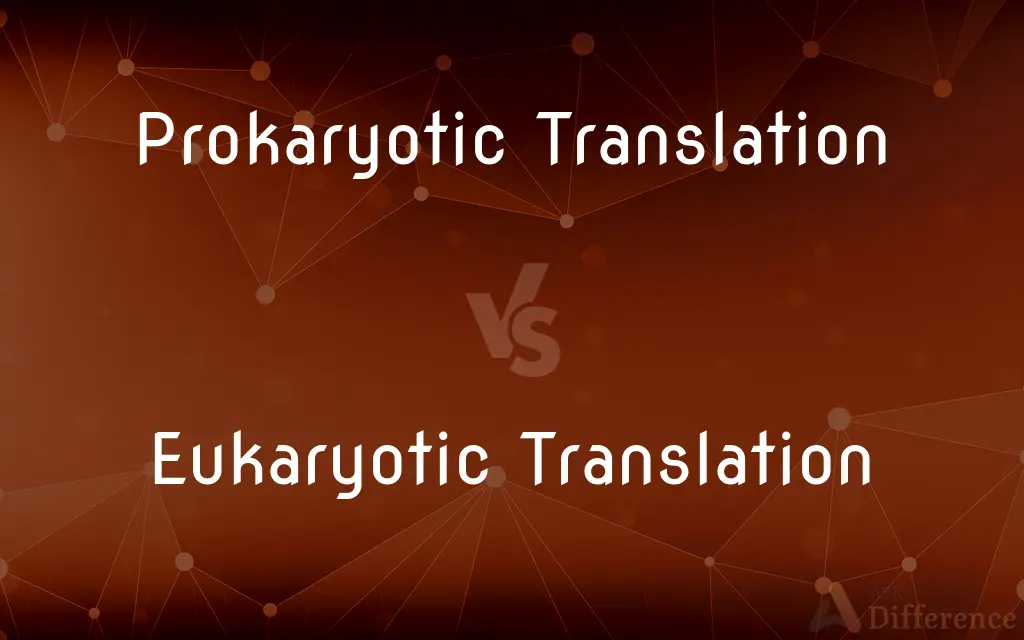Prokaryotic Translation vs. Eukaryotic Translation — What's the Difference?
By Tayyaba Rehman — Published on December 30, 2023
Prokaryotic Translation is protein synthesis in simpler, nucleus-less cells. Eukaryotic Translation is protein synthesis in complex, nucleus-containing cells.

Difference Between Prokaryotic Translation and Eukaryotic Translation
Table of Contents
ADVERTISEMENT
Key Differences
Prokaryotic Translation occurs in bacteria and archaea, organisms without a nucleus. Eukaryotic Translation happens in organisms with a nucleus, like animals, plants, and fungi.
In Prokaryotic Translation, the process begins while the mRNA is still being transcribed. In Eukaryotic Translation, mRNA is first processed and transported to the cytoplasm before translation.
Prokaryotic Translation involves smaller ribosomes (70S). Eukaryotic Translation uses larger ribosomes (80S).
Prokaryotic Translation lacks a 5' cap and poly-A tail on mRNA. Eukaryotic Translation has these modifications for mRNA stability and efficient initiation.
Prokaryotic Translation can be polycistronic, encoding several proteins in one mRNA. Eukaryotic Translation is usually monocistronic, typically encoding one protein per mRNA.
ADVERTISEMENT
Comparison Chart
Cellular Context
In cells without a nucleus
In cells with a nucleus
Ribosome Size
Smaller ribosomes (70S)
Larger ribosomes (80S)
MRNA Processing
No 5' cap or poly-A tail
Has 5' cap and poly-A tail
Translation Initiation
Can start during transcription
Occurs after mRNA processing
Polycistronic Capability
Can be polycistronic
Usually monocistronic
Compare with Definitions
Prokaryotic Translation
Synthesis of proteins in prokaryotes.
Prokaryotic Translation enables bacteria to rapidly adapt to environmental changes.
Eukaryotic Translation
Translation process in cells with a defined nucleus.
Post-transcriptional modifications are crucial for efficient Eukaryotic Translation.
Prokaryotic Translation
Protein synthesis with 70S ribosomes.
Prokaryotic Translation involves a simpler ribosomal structure compared to eukaryotes.
Eukaryotic Translation
Ribosome-mediated protein production in eukaryotes.
Eukaryotic Translation relies on 80S ribosomes for protein synthesis.
Prokaryotic Translation
Polycistronic mRNA translation in prokaryotes.
The polycistronic nature of Prokaryotic Translation allows multiple proteins to be synthesized from one mRNA.
Eukaryotic Translation
Typically monocistronic mRNA translation in eukaryotes.
Each mRNA in Eukaryotic Translation usually codes for a single protein.
Prokaryotic Translation
Translation process lacking a defined nucleus.
Prokaryotic Translation is a target for certain antimicrobial drugs.
Eukaryotic Translation
Protein synthesis in complex, nucleus-containing cells.
Eukaryotic Translation occurs in the cytoplasm of animal and plant cells.
Prokaryotic Translation
Ribosome-mediated protein production in simple cells.
Antibiotics can disrupt Prokaryotic Translation, inhibiting bacterial growth.
Eukaryotic Translation
Protein synthesis with 80S ribosomes.
The complexity of Eukaryotic Translation allows for diverse protein production.
Common Curiosities
What is Prokaryotic Translation?
It's the process of protein synthesis in cells without a nucleus.
How do ribosome sizes differ in Prokaryotic and Eukaryotic Translation?
Prokaryotic Translation uses 70S ribosomes, while Eukaryotic Translation uses larger 80S ribosomes.
What is Eukaryotic Translation?
It's the process of protein synthesis in cells with a nucleus.
Can Prokaryotic Translation occur simultaneously with transcription?
Yes, Prokaryotic Translation can start while mRNA is still being transcribed.
Does Eukaryotic Translation occur in the cytoplasm or nucleus?
It occurs in the cytoplasm, after mRNA is transported out of the nucleus.
Are post-transcriptional modifications important for Eukaryotic Translation?
Yes, modifications like the 5' cap and poly-A tail are crucial for efficient translation.
What makes Prokaryotic Translation a target for antibiotics?
Its unique ribosomal structure and translation mechanisms make it a target for certain antibiotics.
Is the speed of Prokaryotic Translation different from Eukaryotic Translation?
Generally, Prokaryotic Translation can be faster due to its simpler and more direct process.
Is Eukaryotic Translation monocistronic or polycistronic?
It is usually monocistronic, meaning each mRNA typically encodes one protein.
Does Prokaryotic Translation involve mRNA processing?
No, it lacks the mRNA processing steps like the addition of a 5' cap and poly-A tail.
Are there any drugs that specifically target Eukaryotic Translation?
Yes, some drugs can target the unique aspects of Eukaryotic Translation for therapeutic purposes.
How does the absence of a nucleus affect Prokaryotic Translation?
It allows for a more direct and faster translation process without the need for mRNA export.
What is the significance of polycistronic capability in Prokaryotic Translation?
It allows for the synthesis of multiple proteins from a single mRNA, increasing efficiency.
Can Eukaryotic Translation produce multiple proteins from one mRNA?
Generally, no. It usually produces one protein per mRNA, as it's typically monocistronic.
Do both Prokaryotic and Eukaryotic Translation require energy?
Yes, both processes require energy, typically in the form of GTP, to synthesize proteins.
Share Your Discovery

Previous Comparison
Amorphous Polymers vs. Crystalline Polymers
Next Comparison
Tourism Management vs. Hospitality ManagementAuthor Spotlight
Written by
Tayyaba RehmanTayyaba Rehman is a distinguished writer, currently serving as a primary contributor to askdifference.com. As a researcher in semantics and etymology, Tayyaba's passion for the complexity of languages and their distinctions has found a perfect home on the platform. Tayyaba delves into the intricacies of language, distinguishing between commonly confused words and phrases, thereby providing clarity for readers worldwide.












































